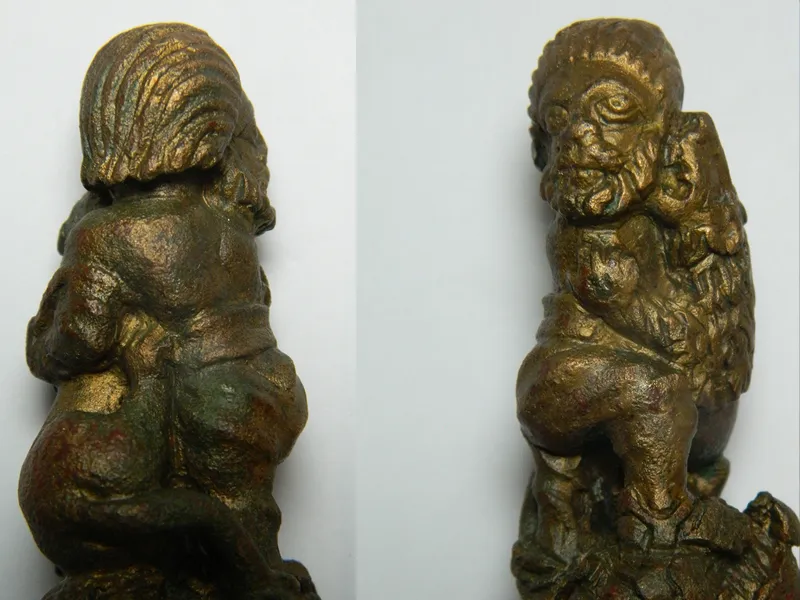Unearthed in Leicester, England, an ornately carved Roman key handle has emerged as a chilling testament to the barbaric practices of the Roman Empire. This unique artifact, meticulously examined by archaeologists and researchers, offers a glimpse into the gruesome world of public executions involving wild animals.
The key handle, crafted from bronze, depicts a scene of horrific violence. It portrays a “Barbarian” – a term Romans used for those outside their empire – engaged in a desperate struggle against a ferocious lion. Adding a layer of disturbing detail, the handle also features four nude children cowering in fear, symbolizing the fate of those who defied Roman rule.
The discovery was made in 2016 by the University of Leicester Archaeological Services (ULAS) during excavations beneath a late Roman townhouse. Following careful cleaning and restoration, the key handle was analyzed by experts at King’s College London. The findings were published in the esteemed journal Britannia.
Dr. Gavin Speed, who led the excavation efforts, described the moment the key handle was unearthed. “It was absolutely astounding,” he remarked. “Initially, it appeared just like any other bronze object, but as we meticulously removed the dirt, tiny faces began to emerge, staring back at us. This discovery is unlike anything ever found before in the Roman Empire.”
The key handle serves as stark evidence of the practice of “damnatio ad bestias,” a gruesome Roman punishment that condemned criminals and prisoners of war to be devoured by beasts in public arenas. This method of execution served a dual purpose: eliminating enemies and instilling fear in those who dared to oppose Roman authority.

Dr. John Pearce, a co-author of the study from King’s College London, emphasized the significance of the find. “This exceptional object provides us with the most detailed depiction of this form of execution ever discovered in Roman Britain. It sheds light on the brutal nature of Roman power in this province.”
The key handle’s central figure, the “Barbarian,” is easily identifiable by his distinctive features – long, mane-like hair, a bushy beard, prominent eyes, and the wearing of pants beneath his bare torso. The ferocious lion has him firmly grasped, its jaws clamped onto the side of his head. In the background, four children huddle together in terror, the older ones seemingly attempting to shield the younger ones, one possibly clutching a stone in a futile attempt to defend themselves. These children represent the “Barbarian” tribe’s future, and their impending demise serves as a chilling reminder of the consequences of resisting Roman conquest.
While amphitheaters and theaters were common features in Roman cities across Britain, serving as venues for these violent spectacles, direct archaeological evidence has been scarce. The presence of the key handle near the recently unearthed Roman theater in Leicester tantalizes with the possibility that the key’s holders might have witnessed such horrors firsthand.
The discovery of the key handle fills a critical gap in our understanding of Roman Britain. While a single puncture wound on a male skeleton from Roman York, inflicted by a large animal, offered a hint of these barbaric practices, the key handle provides a far more detailed and disturbing picture.
Archaeologists estimate that the key was likely crafted well after the Roman conquest of Britain. Interestingly, lions were a recurring motif on Roman key handles in Britain, symbolizing security and protection.This suggests that even after the key itself ceased to function, the detachable handle remained a prized possession, valued for its symbolic meaning. Even when incorporated long after the mansion’s heyday into a new floor, the key handle was positioned upright, perhaps in the belief that it would continue to offer a sense of security.
Nick Cooper, ULAS post-excavation manager and co-author of the study, hailed the key handle as one of the most significant finds from Roman Leicester. Following extensive restoration work scheduled for completion in 2023, the key handle will be placed on display for public viewing at the Jewry Wall Museum in Leicester. This gruesome artifact serves as a potent reminder of the dark side of Roman rule, offering a glimpse into the violent practices employed to maintain power and instill fear.
